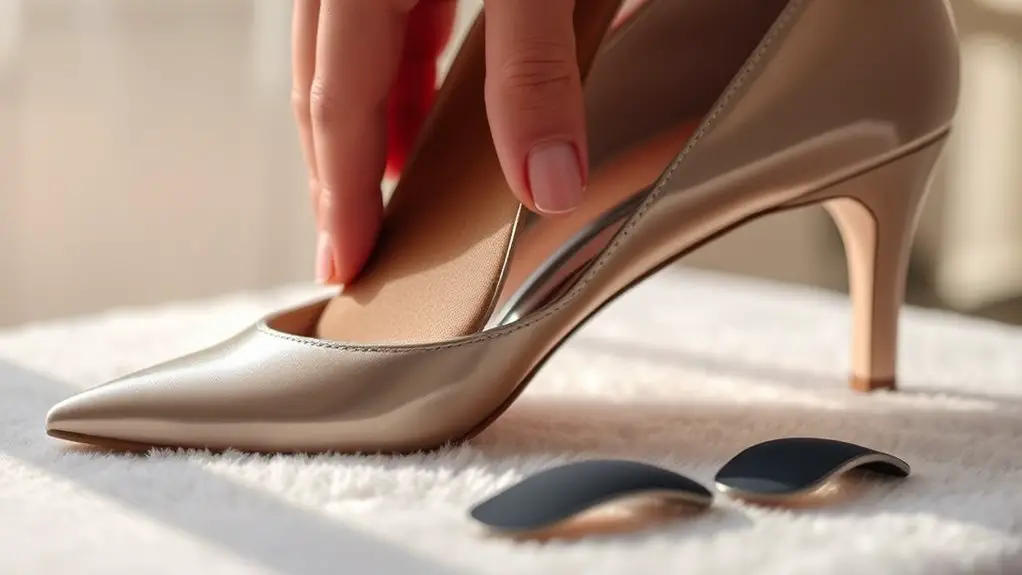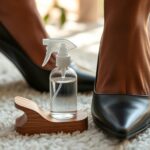To make loose heels fit perfectly, start by using heel grips for better friction and prevent slipping. Insoles can add cushioning and improve foot alignment, while shoe filler inserts help tighten the fit. Adjusting straps and laces can also secure your heels without causing discomfort. If DIY solutions don’t work, visiting a professional cobbler may provide customized adjustments tailored to your feet. Discover other effective methods to enhance your shoe comfort and fit.
Use Heel Grips for Added Friction
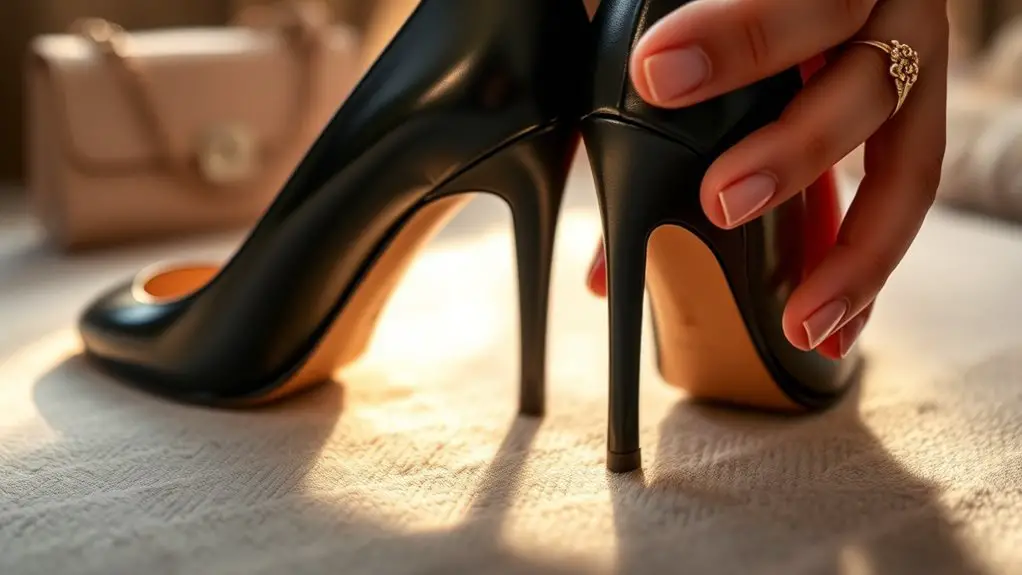
If you find your heels slipping out of your shoes, using heel grips can be a simple yet effective solution. These handy accessories come in various heel grip types, each designed to enhance comfort and stability. You can choose between adhesive grips, which stick directly to the shoe, or gel-based grips that provide extra cushioning.
When selecting heel grips, consider the friction materials used. Silicone grips offer excellent friction and prevent slipping, while foam options provide a softer touch. To apply, make certain your shoe’s interior is clean, peel off the backing from the grip, and press it firmly into place.
Experiment with different types and materials to find what works best for your shoes and foot shape. These small additions can make a significant difference in your comfort and confidence, allowing you to enjoy your favorite footwear without worry.
Try Insoles for Extra Cushioning
To enhance the comfort of loose heels, trying insoles can be a game-changer. Insoles provide extra cushioning that not only helps fill space but also improves your overall foot alignment. When you choose insoles with adequate arch support, you’ll notice a significant reduction in discomfort, especially during long wear.
Look for insoles specifically designed for high heels; these often feature a contoured design that cradles your foot in the right places. By offering better arch support, they help distribute your weight more evenly, reducing pressure points.
When inserting the insoles, make certain they fit snugly within your shoes without cramming your toes. This adjustment can help keep your feet stable, preventing slippage and blisters. With the right insoles, you’ll experience improved comfort and confidence, turning those loose heels into a stylish and enjoyable choice.
Opt for Shoe Filler Inserts
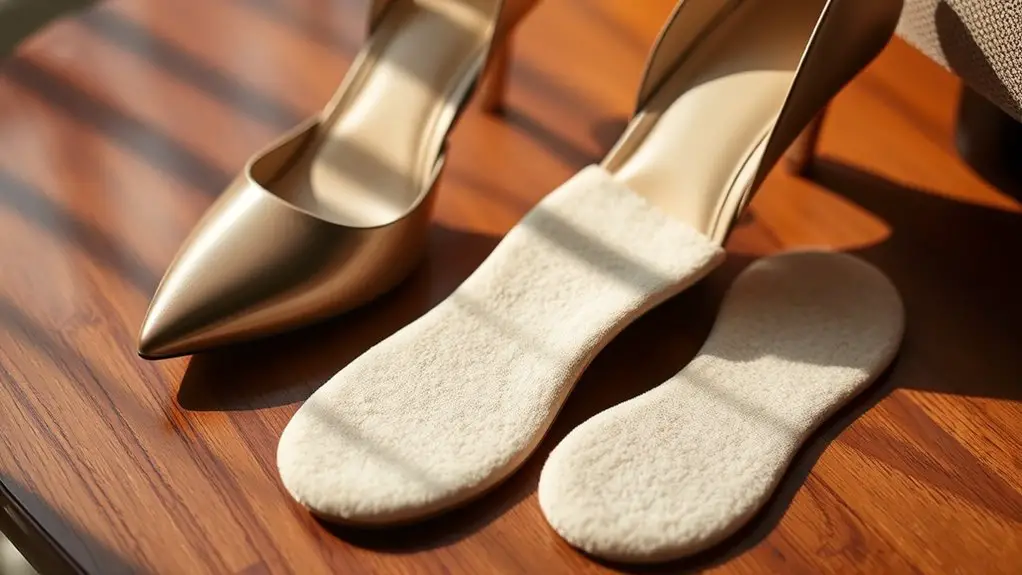
Shoe filler inserts are an excellent solution for addressing the issue of loose heels. These inserts can effectively tighten the fit of various shoe types, guaranteeing comfort and stability. Depending on your shoe’s material choices—like leather, suede, or synthetic—you can find the right filler that matches both your aesthetic and functional needs.
Here’s a quick overview of popular shoe filler inserts:
| Insert Type | Best For |
|---|---|
| Foam Inserts | Casual shoes |
| Gel Inserts | Athletic shoes |
| Silicone Inserts | Dress shoes |
| Fabric Inserts | Everyday wear |
Using these inserts not only enhances fit but also adds cushioning, making your shoes more enjoyable to wear. Evaluate your options based on your specific shoe types and material choices to ascertain you achieve the perfect fit.
Adjust Straps and Laces
One effective way to secure loose heels is by making simple adjustments to straps and laces. Start with strap adjustments; if your heels have an ankle or instep strap, tighten it to create a snug fit. Check that the strap isn’t too tight, which can cause discomfort. If your shoes have multiple adjustable straps, consider using them to enhance stability.
For lace techniques, you can experiment with different lacing styles. One popular method is the “heel lock” technique, where you create a loop at the top eyelet before lacing through the opposite side. This helps anchor your heel in place. Additionally, you might try using shorter laces to maintain tension throughout.
Visit a Professional Cobbler for Custom Solutions
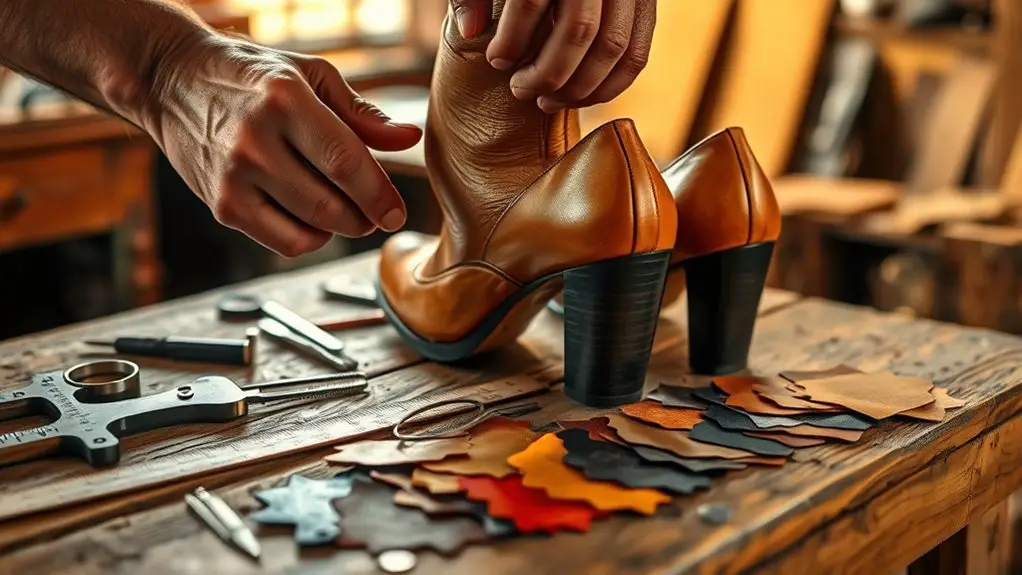
If you’re struggling with loose heels despite your best DIY efforts, visiting a professional cobbler can provide tailored solutions that go beyond simple adjustments. Cobbler services offer expertise in creating custom fittings that align perfectly with your foot shape and the shoe design. Here are four reasons to reflect on consulting a cobbler:
- Precision Fit: They can measure your feet and adjust your shoes for a snug fit.
- Quality Materials: Cobblers use high-quality materials that enhance shoe comfort and durability.
- Specialized Techniques: They employ specialized techniques, like adding padding or adjusting heel height, to guarantee your heels fit seamlessly.
- Long-lasting Solutions: A cobbler can provide solutions that extend the life of your shoes, saving you money in the long run.
Investing in professional help not only improves your shoe fit but also enhances overall comfort, making your footwear experience much more enjoyable.
Frequently Asked Questions
Can Loose Heels Cause Long-Term Foot Problems?
Loose heels can definitely lead to long-term foot problems. When shoes don’t fit right, it disrupts foot mechanics and can cause issues with shoe structure, leading to discomfort and potential injuries down the line.
How Do I Choose the Right Type of Insole?
When choosing an insole, consider materials like gel or foam for comfort. Make certain it matches your foot arch type—high, medium, or low—for proper support. A well-fitted insole can improve overall foot alignment and comfort.
Are There Specific Brands for Heel Grips and Insoles?
When it comes to heel grips and insoles, you’ll find countless brands vying for your attention. Look for product reviews on trusted sites; brand recommendations like Dr. Scholl’s or Foot Petals can be game-changers for comfort.
Can I Use Multiple Solutions Together for Better Fit?
Absolutely, you can use combination solutions for an ideal fit. Pairing heel grips with insoles or thicker socks can enhance comfort and stability, ensuring your shoes feel secure while reducing friction and potential blisters.
How Often Should I Replace My Shoe Fillers?
You should replace shoe fillers regularly, preferably every few months, to maintain effectiveness. For maximum comfort enhancement techniques, check for wear signs. Consistent shoe maintenance tips guarantee your footwear remains comfortable and supportive over time.

